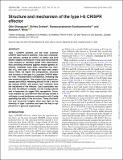Files in this item
Structure and mechanism of the type I-G CRISPR effector
Item metadata
| dc.contributor.author | Shangguan, Qilin | |
| dc.contributor.author | Graham, Shirley | |
| dc.contributor.author | Sundaramoorthy, Ramasubramanian | |
| dc.contributor.author | White, Malcolm F. | |
| dc.date.accessioned | 2022-11-09T17:30:35Z | |
| dc.date.available | 2022-11-09T17:30:35Z | |
| dc.date.issued | 2022-10-28 | |
| dc.identifier | 281628358 | |
| dc.identifier | 9456d849-8b83-461e-8c02-4954863af113 | |
| dc.identifier | 000876644300001 | |
| dc.identifier | 85141890487 | |
| dc.identifier | 000876644300001 | |
| dc.identifier.citation | Shangguan , Q , Graham , S , Sundaramoorthy , R & White , M F 2022 , ' Structure and mechanism of the type I-G CRISPR effector ' , Nucleic Acids Research , vol. 50 , no. 19 , pp. 11214-11228 . https://doi.org/10.1093/nar/gkac925 | en |
| dc.identifier.issn | 0305-1048 | |
| dc.identifier.other | ORCID: /0000-0003-1543-9342/work/122720293 | |
| dc.identifier.other | ORCID: /0009-0001-4376-6343/work/138747462 | |
| dc.identifier.other | ORCID: /0000-0002-2608-3815/work/160753804 | |
| dc.identifier.uri | https://hdl.handle.net/10023/26352 | |
| dc.description | Funding: This work was supported by the Biotechnology and Biological Sciences Research Council (REF: BB/S000313/1 to MFW), Medical Research Council (REF: MR/S021647/1 to RS) and the China Scholarship Council (REF: 202008060345 to QS). | en |
| dc.description.abstract | Type I CRISPR systems are the most common CRISPR type found in bacteria. They use a multisubunit effector, guided by crRNA, to detect and bind dsDNA targets, forming an R-loop and recruiting the Cas3 enzyme to facilitate target DNA destruction, thus providing immunity against mobile genetic elements. Subtypes have been classified into families A-G, with type I-G being the least well understood. Here, we report the composition, structure and function of the type I-G Cascade CRISPR effector from Thioalkalivibrio sulfidiphilus, revealing key new molecular details. The unique Csb2 subunit processes pre-crRNA, remaining bound to the 3′ end of the mature crRNA, and seven Cas7 subunits form the backbone of the effector. Cas3 associates stably with the effector complex via the Cas8g subunit and is important for target DNA recognition. Structural analysis by cryo-Electron Microscopy reveals a strikingly curved backbone conformation with Cas8g spanning the belly of the structure. These biochemical and structural insights shed new light on the diversity of type I systems and open the way to applications in genome engineering. | |
| dc.format.extent | 15 | |
| dc.format.extent | 6539265 | |
| dc.language.iso | eng | |
| dc.relation.ispartof | Nucleic Acids Research | en |
| dc.subject | GUIDED SURVEILLANCE COMPLEX | en |
| dc.subject | PROCESSES PRE-CRRNA | en |
| dc.subject | EVOLUTIONARY CLASSIFICATION | en |
| dc.subject | CRYSTAL-STRUCTURE | en |
| dc.subject | RNA | en |
| dc.subject | CASCADE | en |
| dc.subject | RECOGNITION | en |
| dc.subject | ARCHAEAL | en |
| dc.subject | BINDING | en |
| dc.subject | QH301 Biology | en |
| dc.subject | QH426 Genetics | en |
| dc.subject | DAS | en |
| dc.subject | MCC | en |
| dc.subject.lcc | QH301 | en |
| dc.subject.lcc | QH426 | en |
| dc.title | Structure and mechanism of the type I-G CRISPR effector | en |
| dc.type | Journal article | en |
| dc.contributor.sponsor | BBSRC | en |
| dc.contributor.institution | University of St Andrews. School of Biology | en |
| dc.contributor.institution | University of St Andrews. Biomedical Sciences Research Complex | en |
| dc.contributor.institution | University of St Andrews. St Andrews Bioinformatics Unit | en |
| dc.identifier.doi | 10.1093/nar/gkac925 | |
| dc.description.status | Peer reviewed | en |
| dc.identifier.grantnumber | BB/S000313/1 | en |
This item appears in the following Collection(s)
Items in the St Andrews Research Repository are protected by copyright, with all rights reserved, unless otherwise indicated.

